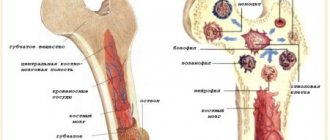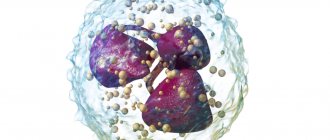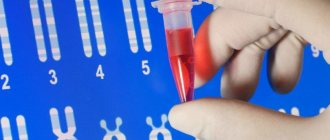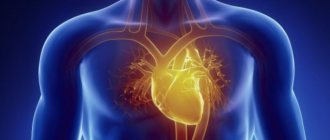Myoglobin is a protein found in the heart and skeletal muscles.
It traps oxygen in muscle cells, allowing them to produce the energy needed for muscle contraction. When the heart or skeletal muscles are damaged, myoglobin is released into the blood, where it circulates for several hours. It is then filtered from the blood by the kidneys and excreted from the body in urine. High concentrations of myoglobin are toxic to the kidneys, and in severe injuries, the release of myoglobin into the blood can lead to kidney failure.
Myoglobin can be used as an auxiliary test in the diagnosis of myocardial infarction, but it is not specific for this disease, since it is released into the blood when any muscle is damaged. One of the common causes of a sharp increase in myoglobin in the blood is rhabdomyolysis, the rapid breakdown of muscle tissue. It can be caused by severe injuries (for example, in a car accident), electric shock, burns, thrombosis, intoxication, certain infections (HIV, influenza, streptococcus), uncontrolled diabetes, hypo- and hyperthyroidism, and late-stage muscular dystrophies.
Detailed description of the study
Myoglobin is a specific protein found in muscle cells of skeletal muscles and the heart. Also, a small part of the protein can be synthesized in blood vessels, liver, and brain. It has a greater affinity for oxygen than hemoglobin. This determines two important functions of protein - the accumulation of oxygen in tissues and its use at critically low levels of oxygen in the muscle. Oxygen is transported to the mitochondria, where reactions occur to produce energy for the cells.
Myoglobin enters the blood when the myocardium and skeletal muscles are damaged. Myoglobin analysis is most often used to diagnose heart damage - myocardial infarction. It manifests itself as severe pain in the chest area, pain can radiate to the left arm, jaw, and stomach. Sweating, shortness of breath, nausea, and loss of consciousness are also sometimes observed. Symptoms mainly occur at rest.
The advantages of myoglobin include the fact that this protein is the earliest marker of myocardial infarction. It very quickly enters the bloodstream when cardiomyocytes (heart muscle cells) are destroyed and can be detected within an hour after a heart attack. The indicator reaches its highest values after 4-12 hours and returns to normal within 24 hours. However, this analysis is not specific for infarction, therefore, to clarify the diagnosis, the analysis should be performed together with the determination of other markers of myocardial damage (troponin and creatine kinase-MB).
Myoglobin levels also increase when skeletal muscles are damaged due to the following diseases:
- Myositis is inflammation of muscle tissue. Symptoms include fever, muscle weakness and muscle pain.
- Myodystrophies are mainly represented by Duchenne or Becker muscular dystrophy. They are hereditary diseases and are accompanied by paresis, paralysis, cardiac disorders, and damage to the respiratory system. Duchenne muscular dystrophy manifests itself in early childhood with rapid progression of symptoms and immobility. Becker's dystrophy has a milder course, debuts later, at the age of 10-20 years, and is characterized by slowly increasing muscle weakness, which allows people with this disease to maintain the ability to walk independently for a long time.
- Compression syndrome, which occurs when long-term compressed areas of the body are released by heavy objects (during natural and man-made disasters, landslides). As a result, toxic substances (myoglobin, creatinine, potassium and calcium ions, lysosomal enzymes, etc.) are released into the blood from damaged tissues, which can lead to acidosis (increased blood acidity) and the development of renal failure.
It must be said that myoglobin is excreted unchanged by the kidneys. If their function is impaired (kidney failure), the level of protein in the blood may be elevated. Excessive protein excretion also has a negative impact on kidney function.
Thus, determining the level of myoglobin in the blood serum together with other markers makes it possible to timely diagnose myocardial infarction and diseases associated with damage to skeletal muscles, and therefore prescribe treatment in a timely manner and reduce the risk of complications.
Myoglobin
Myoglobin is a protein that binds oxygen and supplies it to skeletal muscles. Its concentration in the blood increases when skeletal muscles or myocardium are damaged.
English synonyms
Myoglobin.
Research method
Immunoturbidimetry.
Units
μg/L (micrograms per liter).
What biomaterial can be used for research?
Venous blood.
How to properly prepare for research?
- Do not eat for 2-3 hours before the test (you can drink clean still water).
- Avoid physical and emotional stress for 30 minutes before the test.
- Do not smoke for 30 minutes before donating blood.
General information about the study
Myoglobin is a protein found in skeletal muscle and cardiac muscle - the myocardium. It is able to bind oxygen in muscle cells, which gives them energy to contract. Normally, there is so little myoglobin in the blood that it cannot be determined by laboratory methods. When skeletal muscle or myocardium is damaged, myoglobin enters the bloodstream in large quantities. It is not a specific marker of myocardial damage, unlike creatine kinase MB and troponin, but it is one of the first to respond to the death of cardiac muscle cells - after 1-2 hours its concentration in the blood increases.
Myoglobin is filtered by the kidneys and excreted from the body in urine. If massive muscle damage occurs, such as from a serious injury, it enters the blood in large quantities and can damage the kidneys, causing acute kidney failure.
What is the research used for?
Myoglobin testing is typically ordered along with other markers of heart muscle damage, such as creatine kinase MB, and is used to confirm or rule out myocardial infarction in patients with acute heart pain or other symptoms.
Myoglobin begins to rise 1-2 hours after myocardial injury, reaches its peak after 8-12 hours and usually returns to normal by the end of the day. Troponin is the gold standard for detecting infarction as it is more specific, but the advantage of myoglobin is that it reacts as early as possible, thereby allowing a quicker diagnosis. On the other hand, it is necessary to understand that myoglobin can increase without damaging the heart muscle. Thus, a negative myoglobin test result excludes a heart attack, a positive one requires confirmation with troponin.
Sometimes a myoglobin test is needed in people with serious injuries to determine the likelihood of kidney damage.
When is the study scheduled?
A myoglobin test is prescribed if acute myocardial infarction is suspected. Blood is taken immediately upon admission of the patient to the hospital and then several more times every 2-3 hours.
This test is usually prescribed in conjunction with other markers of cardiac muscle damage, such as creatine kinase MB and troponin, which makes it possible to more confidently judge the presence or absence of acute damage to the heart muscle.
In addition, this study may be needed after massive skeletal muscle injuries to assess the risk of kidney damage and acute renal failure.
What do the results mean?
Reference values
| Floor | Reference values |
| Male | 19 – 92 µg/l |
| Female | 12 – 76 µg/l |
Usually the myoglobin content in the blood is so insignificant that it cannot even be measured.
An increase in myoglobin levels in the blood indicates recent damage to skeletal or cardiac muscles. The administration of troponin or creatine kinase MB makes it possible to clarify the cause of the increase in myoglobin. If there is no increase in myoglobin within 12 hours of chest pain, the likelihood of a myocardial infarction is extremely unlikely.
Since myoglobin, in addition to the heart, is also contained in skeletal muscles, it can increase in other situations:
- long-term compression syndrome (crash syndrome) occurs as a result of crushing or crushing of muscle tissue, as well as prolonged cessation of blood flow through the limb;
- any injuries;
- after surgical operations;
- convulsions of any origin;
- any diseases that lead to muscle damage: dermatomyositis, polymyositis, muscular dystrophy, etc.
What can influence the result?
- Hemolysis and lipemia distort the test results.
- Abuse of amphetamines and alcohol increases myoglobin levels.
- Because myoglobin is excreted through the kidneys, its levels may be elevated in renal failure.
Important Notes
- Intramuscular injections and physical activity do not affect the level of myoglobin in the blood.
- An elevated myoglobin level is not a sufficient basis for making a diagnosis of myocardial infarction. A comprehensive assessment of the patient’s condition is required, which can only be carried out by a doctor. This takes into account the nature of the pain syndrome, the history of the development of the disease, ECG, and the results of other laboratory and instrumental examinations.
- Normally, myoglobin is not detected in urine, as there is so little of it in it. If the myoglobin level rises enough to be measured, it indicates the possibility of kidney failure.
Also recommended
- Troponin I
- Creatine kinase total
- Creatine kinase MV
- Alanine aminotransferase (ALT)
- Aspartate aminotransferase (AST)
- Lactate dehydrogenase 1, 2 (LDH 1, 2 fractions)
Who orders the study?
General practitioner, therapist, cardiologist.
References
- Kuleva, N.V., Krasovskaya, I.E. New role of myoglobin in the functioning of cardiac and skeletal muscles. Biophysics, 2021. - T. 61(5). — P. 861-864.
- Clinical protocol for the diagnosis and treatment of progressive Duchenne/Becker muscular dystrophy, 2021. - 19 p.
- Chaulin, A.M., Duplyakov, D.V. Biomarkers of acute myocardial infarction: diagnostic and prognostic value. Clinical practice, 2021. - No. 3.
- Clinical protocol for the diagnosis and treatment of idiopathic inflammatory myopathies, 2021. - 29 p.
- Clinical laboratory diagnostics. National leadership. In 2 volumes / ed. V.V. Dolgova, V.V. Menshikov. - M.: GEOTAR-Media, 2012. - 928 p.
- Acute myocardial infarction with ST segment elevation of the electrocardiogram. Clinical guidelines, 2021. - 157 p.
What do the test results mean?
The myoglobin content in the blood of a healthy person is negligible. An increase in the level of this substance indicates damage to muscle tissue and can be caused by myocardial infarction, trauma, injury, convulsions, and surgery. Myoglobin increases with rhabdomyolysis, muscular dystrophies and myositis (inflammation of skeletal muscles).
To assess kidney function when myoglobin in the blood increases, in some cases the concentration of myoglobin in the urine is also measured. The higher the level in urine, the greater the risk of developing acute kidney failure and kidney failure. In addition to injuries and other causes described above, urinary myoglobin may increase after excessive physical activity in untrained athletes, viral infections, or exposure to toxins or medications.
Conclusion
With proper distribution of the load on the muscle group and a healthy, balanced diet and lifestyle, myoglobin will be within standard values.
The role of this protein is very important in the human body: providing oxygen to muscle cells, transporting oxygen to its destination and transporting carbon dioxide to the lungs.
With a normal reading of myoglobin in the blood, there will be an uninterrupted operation of the gas exchange process in the body for the proper functioning of life-supporting organs.
(
1 ratings, average: 5.00 out of 5)
Normal myoglobin index
Standard indicators may increase upward and depend on laboratory research methods:
- Diagnostic test – immuno-nephelometric,
- RIA radioimmunoassay analysis,
- Study using immunofluorescence analysis.
Despite the varying sensitivity of laboratory tests, the volume of myoglobin does not exceed the index from 65.0 to 80.0 μg/l.
Standard indicator:
- For representatives of the stronger sex from 19.0 to 92.0 μg/l,
- For the female body from 12.0 to 76.0 μg/l,
- The average normative coefficient is 49.0, and also more or less by 17.0 units (for males),
- The average standard for women is 35.0, and also more or less by 14.0,
- The concentration of myoglobin molecules in urine is less than the index of 20.0 μg/l; in an absolutely healthy body, myoglobin protein should not be present in urine.
When the myoglobin index in the blood differs from the normative units, then myoglobinemia is diagnosed.
If the presence of myoglobin in urine is detected during the analysis, then a diagnosis of myoglobinuria is made.
Index increased
Physiological increase in muscle type hemoglobin. The causes are related to the load on the skeletal muscle tissue, especially during sports and training, as well as when using physical therapy with electrical impulses.
A pathological increase in the index occurs in the following diseases:
- Damage to the heart muscle during myocardial infarction (hemoprotein increases, and the level of creatine kinase also increases). Myoglobin increases 30 minutes after the onset of pain, and its presence can be detected even 3 days after the attack,
- Kidney failure and uremic syndrome,
- Inflammation that occurs in muscle tissue
- In case of injury,
- Deep thermal tissue burns,
- Chemical burns in muscle tissue,
- Muscle cramps,
- After surgery,
- Muscle dystrophy.
Index downgraded
The muscle type hemoglobin index in the blood decreases only under the influence of pathology, such as:
- Arthritis of rheumatoid type,
- Inflammation of muscle tissue polymyositis,
- Myasthenia gravis is the presence of antibodies in the blood that affect myoglobin.
Polymyositis
When should a myoglobin test be done?
Blood biochemistry for the presence of myoglobin is done if it is suspected:
- Cardiac muscle infarction in the acute stage of pathology during its initial diagnostic study,
- Severe damage or destruction of skeletal muscle tissue,
- Pathology myopathy,
- The disease polymyositis,
- When monitoring the treatment of a heart attack.
In case of acute heart attack, blood for myoglobin is taken immediately upon admission of the patient to the clinic. Also to control the disease several times, at intervals of 3 hours.
The indications of this marker are very important in case of recurrent disease, and are prescribed in combination with other markers such as creatine kinase and troponin. This complex of biochemistry makes it possible to fully assess the degree of damage to the muscles of the cardiac organ.
Preparing for analysis
To study biological material for myoglobin, the following are suitable: blood serum, plasma, or even urine. All biological materials must be freshly collected.
In order to obtain the most correct result of myoglobin indicators, it is necessary to follow the rules before and during the collection of material:
- It is recommended to donate blood in the morning,
- Last meal at least 8-9 hours before venous blood sampling,
- Do not drink alcohol in the last 48 hours before submitting the material for analysis,
- You can only drink clean water before donation,
- Coffee, juices, tea, and other drinks are prohibited during this period to avoid distorted material,
- Smoking is prohibited at least 60 minutes before the test.
- Half an hour before the procedure, stop all activity,
- Before taking the test, do not be nervous and be in a calm state,
- Do not carry out the procedure immediately after x-rays, as well as after ultrasound,
- Do not test after physiotherapy.
Myoglobin analysis is an important diagnostic step, especially in the treatment of heart attack.
The results of the analysis make it possible to track the effectiveness of treatment, and if necessary, adjust the medication course.
What are muscle hemoglobin molecules?
Myoglobin is a protein that is present in striated muscles, similarly located in myocardial tissue. Myoglobin is part of a group of chromoprotein molecules.
Myoglobin contains a gene that is interconnected with part of the body’s proteins and is part of the prosthetic group. The myoglobin molecule contains amino acid components.
A protein is a monomer that consists of a single chain.
There are structures of a protein molecule:
- The primary structure is the monomer stage, consisting of a polypeptide linking chain, which includes amino acid residues,
- The structure of the secondary confirmation stage , which has an α-helical shape and 75.0% of molecules have this structure,
- The tertiary type structure has an α-helical shape, which is folded into a compact globule.
To determine the structure of a tertiary species, an X-ray analysis method is needed.











